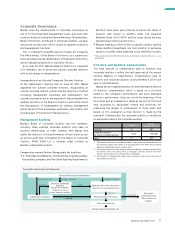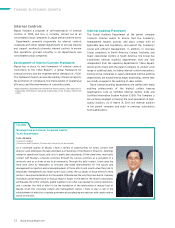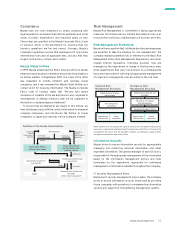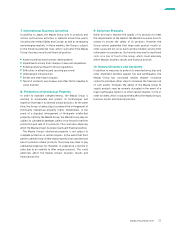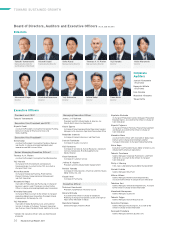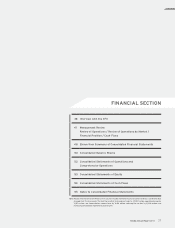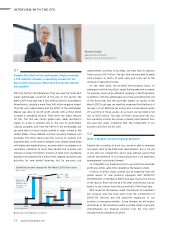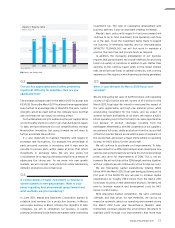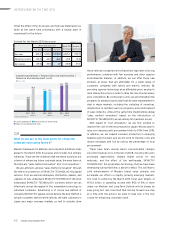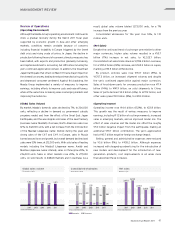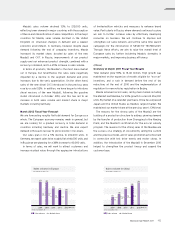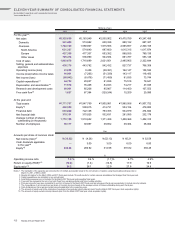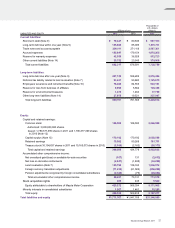Mazda 2011 Annual Report Download - page 43
Download and view the complete annual report
Please find page 43 of the 2011 Mazda annual report below. You can navigate through the pages in the report by either clicking on the pages listed below, or by using the keyword search tool below to find specific information within the annual report.
MANAGEMENT REVIEW
Review of Operations
(Operating Environment)
Although the Mazda Group’s operating environment continued to
show a gradual recovery during the March 201 1 fiscal year,
supported by economic growth in Asia and other emerging
markets, conditions remain unstable because of concerns
including financial instability in Europe triggered by the Greek
debt crisis and rising crude oil prices. In Japan, the decline in
production following the end of economic stimulus measures has
been halted, with exports and production gradually increasing,
and capital investment is recovering, but difficulties including the
yen’s continued appreciation remain. In addition, the Great East
Japan Earthquake that struck on March 1 1 had a major impact on
the domestic economy, leading to reduced manufacturing activity
and depressed consumer sentiment. Against this backdrop, the
Mazda Group implemented a variety of measures to improve
earnings, including efforts to improve costs and raise efficiency,
while at the same time increasing sales in emerging markets and
improving the model mix.
(Global Sales Volume)
By market, Mazda’s domestic sales declined by 7%, to 206,000
units, reflecting a decline in demand as government subsidy
programs ended and from the effect of the Great East Japan
Earthquake, and this was despite solid sales of the new Premacy
(overseas name: Mazda5). Overseas, North American sales rose
12%, to 342,000 units, with a net increase from the introduction
of the Mazda2 (Japanese name: Demio) during the year, and
strong sales of the CX-7 and CX-9. In Europe, sales in Russia
turned around to record growth, but overall demand declined and
sales were 12% lower, at 212,000 units. With solid sales of leading
models including the Mazda3 (Japanese name: Axela) and
Mazda6 (Japanese name: Atenza), sales in China grew 20%, to
236,000 units. Sales in other markets rose 20%, to 277,000
units, on solid results in ASEAN markets and in Australia. As a
result, global sales volume totaled 1,273,000 units, for a 7%
increase from the previous year.
Consolidated wholesales for the year rose 14%, to 1.10
million units.
(Net Sales)
Despite the continued trend of a stronger yen relative to other
major currencies, higher sales volume resulted in a ¥161.7
billion (7%) increase in net sales, to ¥2,325.7 billion.
Consolidated net sales broke down as ¥1,784.2 billion overseas,
for a ¥195.2 billion (12%) increase, and ¥541.5 billion in Japan,
marking a ¥33.5 billion (6%) decline.
By product, vehicles sales rose ¥133.7 billion (8%), to
¥1,707.3 billion, on increased shipment volumes and despite
the yen’s continued appreciation against major currencies.
Sales of knockdown parts for overseas production rose ¥17.4
billion (14%), to ¥141.9 billion, on solid shipments to China.
Sales of parts declined ¥9.2 billion (4%), to ¥217.2 billion, and
other sales grew ¥19.9 billion (8%), to ¥259.3 billion.
(Operating Income)
Operating income rose ¥14.4 billion (152%), to ¥23.8 billion.
This growth was the result of various measures to improve
earnings, including ¥1 1.2 billion of cost improvements, increased
sales in emerging markets, and an improved model mix. The
effect of sales volumes and the model mix offset the roughly
¥5.0 billion negative impact from the earthquake, making an
additional ¥35.7 billion contribution. The yen’s appreciation
had a ¥43.7 billion negative foreign exchange impact.
Selling, general and administrative expenses were reduced
by ¥5.6 billion (1%), to ¥438.2 billion. Although expenses
increased with stepped-up advertising for the introduction of
new models and development for the introduction of new-
generation products, cost improvements in all areas more
than absorbed these increases.
2007
Global sales volume
Thousands of units
2008 2009 2010 2011
1,302 1,363
1,261 1,193 1,273
(Years ended March 31)
2007 2008 2009 2010 2011
1,177
913
264
983
257
896
220
744
219
894
206
1,240
1,116
963
1,100
Consolidated wholesales
Thousands of units
(Years ended March 31)
2007 2008 2009 2010 2011
3,247.5 3,475.8
2,535.9
2,163.9 2,325.7
Net sales
Billions of yen
(Years ended March 31)
Domestic Overseas
Mazda Annual Report 201 1 41


